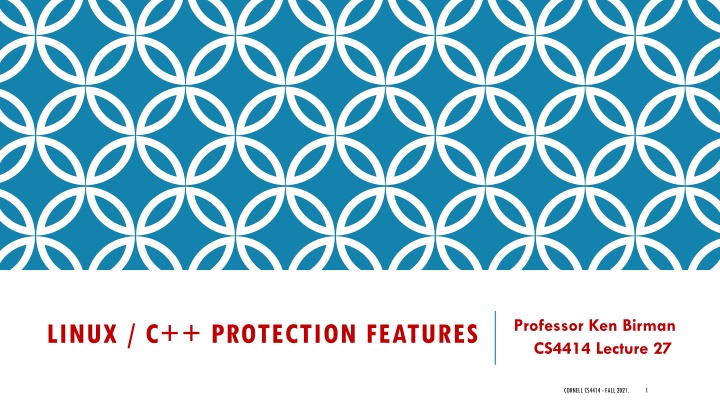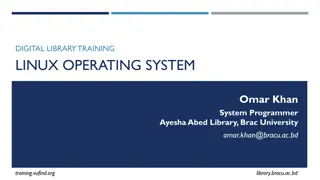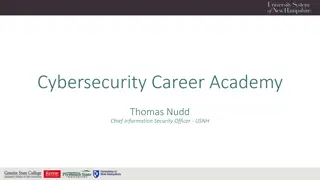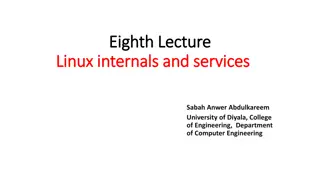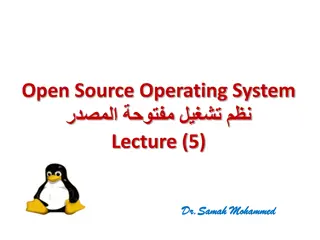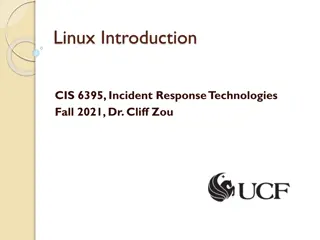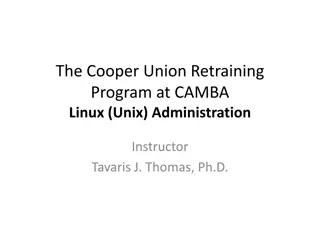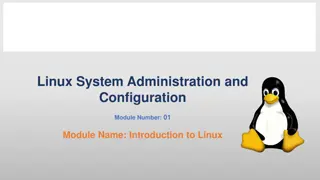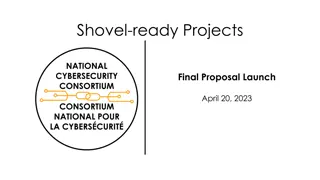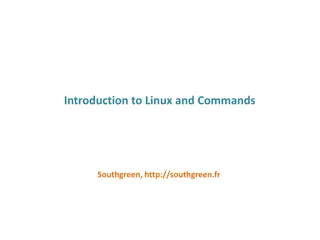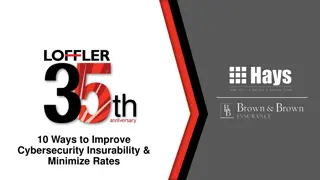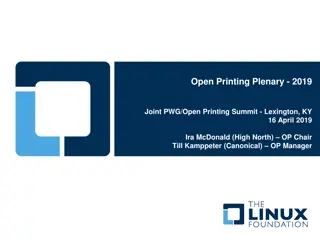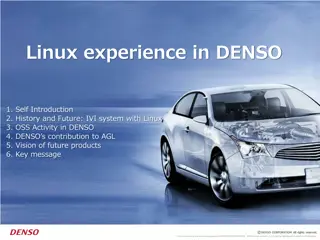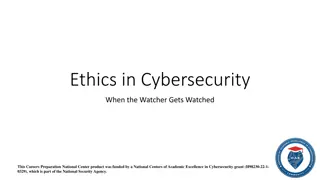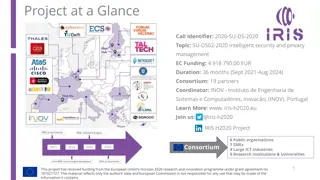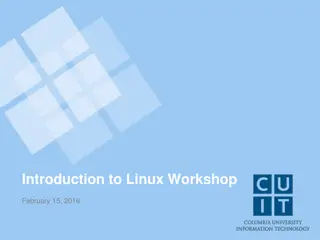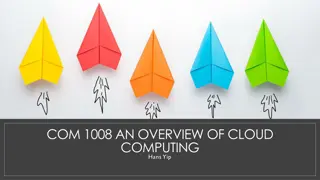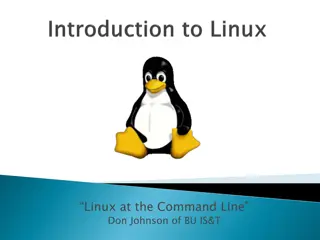Enhancing Cybersecurity in Modern Linux Systems
Explore the evolving landscape of cybersecurity in Linux systems as discussed in Professor Ken Birman's CS4414 lecture series at Cornell University. The focus is on protection features, defense strategies, code reviews, and continuous efforts to secure Linux platforms against exploits and vulnerabilities. Learn about memory protection, type checking, API scrutiny, and the persistent challenges in identifying and mitigating bugs in Linux codebase.
Download Presentation

Please find below an Image/Link to download the presentation.
The content on the website is provided AS IS for your information and personal use only. It may not be sold, licensed, or shared on other websites without obtaining consent from the author.If you encounter any issues during the download, it is possible that the publisher has removed the file from their server.
You are allowed to download the files provided on this website for personal or commercial use, subject to the condition that they are used lawfully. All files are the property of their respective owners.
The content on the website is provided AS IS for your information and personal use only. It may not be sold, licensed, or shared on other websites without obtaining consent from the author.
E N D
Presentation Transcript
Professor Ken Birman CS4414 Lecture 27 LINUX / C++ PROTECTION FEATURES CORNELL CS4414 - FALL 2021. 1
IDEA MAP FOR TODAY It s a (cyber)war out there! Firewalls and Memory Protection Type Checking as a Protection Tool Concept of Defense in Depth We actually can protect valuable systems! CORNELL CS4414 - FALL 2021. 2
HACKING: WHAT HAVE WE LEARNED? by 1988, Unix was a terrible mess riddled with holes! Linux emerged in 1991 but inherited many of the same issues. In fact in the subsequent 31 years, many have been fixed. But nobody doubts that many remain! Today, there is far more emphasis on hardening these platforms against exploits of all kinds. CORNELL CS4414 - FALL 2021. 3
CODE AND PLATFORM REVIEWS Companies like the one we touched on in Lecture 26 are getting contracts to review the code for Unix, Linux and major applications. Many work with their own tools, and apply them to the code base to search for risky business. Then they report the issues as potential bugs. There are companies that maintain Linux, and they fix the bugs. Unix is a legacy system and no longer maintained, or in wide use. CORNELL CS4414 - FALL 2021. 4
MODERN LINUX Every single use of memcpy and strcpy and similar functions has been extensively checked. This should have reduced the risk of buffer overrun attacks substantially. Tools (similar to Valgrind) exist that do automated checks for unsafe copying, and have been used on Linux by professionals. CORNELL CS4414 - FALL 2021. 5
MODERN LINUX All APIs have been scrutinized too, by red teams These are groups funded to try and find a flaw Often they include people who were previously black-hat hackers but were caught, or perhaps switched to the good side. This includes every single privileged application, within the standard Linux distributions. CORNELL CS4414 - FALL 2021. 6
EVERYONE IS SURE THAT BUGS REMAIN It is particularly hard to check Linux for bugs. One concrete issue is that Linux is coded in C, which has pointers, threads, shared memory, interrupts, etc. These features leave many opportunities for subtle race conditions and other errors. Sophisticated hackers sometimes find such issues, then find exploits that somehow target them. CORNELL CS4414 - FALL 2021. 7
IDEAL WORLD? In languages that enable very rich specifications for modules and code, we can use formal prover tools to go much further For each method, we arrive at invariants about the situations in which it would run, and that it must reestablish after executing. Then the developer works to prove that the methods satisfy these properties, using the theorem provers. CORNELL CS4414 - FALL 2021. 8
BUT The languages in which proving is most successful are often very heavily type-checked in ways that preclude the kinds of high- efficiency logic we ve explored in CS4414. it would be nice if this could change, and over time, it will. But C and C++ are very far from being verifiable in this sense. CORNELL CS4414 - FALL 2021. 9
C-CURED, RUST There are C-like languages that are much more strongly checkable. C-Cured and Rust are famous examples. They bring significant costs both at compile time and runtime. People have created versions of Linux using these languages, and even proved properties (most of correctness ) for compilers But Linux is used in a million ways and is huge and complex. Many features are omitted in these proved-correct Linux systems. CORNELL CS4414 - FALL 2021. 10
TYPE CHECKING, MEMORY PROTECTION Modern systems deal with a tradeoff We can harden them by doing aggressive type checking and using restrictions on what individual segments of memory can contain and how they can be used. But these steps harm performance CORNELL CS4414 - FALL 2021. 11
IS THERE HOPE? DEFINITELY!!! If you find yourself working on a safety-critical application, you can and should consider these proved correct packages. For general purposes, progress has been slower. Over the span of years we are definitely seeing coverage expand (not quickly). Key insight? Your system will be under attack. No program is bullet-proof. So, anticipate issues and build in self-checks that can detect and repair compromised elements. Like fault-tolerance. CORNELL CS4414 - FALL 2021. 12
IS THERE HOPE? DEFINITELY!!! If you find yourself working on a safety-critical application, you can and should consider these proved correct packages. For general purposes, progress has been slower. Over the span of years we are definitely seeing coverage expand (not quickly). Key insight? Your system will be under attack. No program is bullet-proof. So, anticipate issues and build in self-checks that can detect and repair compromised elements. Like fault-tolerance. CORNELL CS4414 - FALL 2021. 13
YOU NEED TO PROTECT THE HARDWARE, THE PLATFORM AND THE APPLICATIONS Imagine that you have been hired to look into a rash of burglaries. You visit and discover that none of the homes had locks on the doors. You recommend locks. The next year you visit again the problem is just as bad! Now the crooks are climbing up to the second floor windows. CORNELL CS4414 - FALL 2021. 14
THEY ADDED BARS TO WINDOWS A year later, the windows are all locked. But they need more help! Auto-installed malware has infected all the smart refrigerators, which have Linux-based controllers. But now you have a problem: disabling updates seems risky too! CORNELL CS4414 - FALL 2021. 15
PUZZLE: LINUX IS THE HOUSE We can do a reasonable job of securing Linux and its tools But how can we secure the whole enchilada? Linux plus tools plus random applications? Most enterprises have specific configurations or packages they approve, and you just aren t allowed to download others! CORNELL CS4414 - FALL 2021. 16
IN MODERN SYSTEMS, UPDATES AND APPLICATIONS ARE INCREASINGLY THE ISSUE! We take Linux, but then we install applications on them, and give these permission to accept and send requests. Many employ components from open-source suppliers that don t necessarily use the best practices. If an application is insecure, it won t matter if Linux itself is secure: anything that application can read or update can be compromised. CORNELL CS4414 - FALL 2021. 17
SOME PROTECTIONS ARE BUILT IN For example, you can tell C++ to compile with address space randomization automatically performed. You can also take compiler warnings seriously and can even use proof tools for ultra-sensitive portions of your code, like the algorithms used to decide which data to trust during self-repair None of this will compensate for bugs and you can t avoid bugs! CORNELL CS4414 - FALL 2021. 18
EXAMPLE: LETS REVISIT THE ISSUE OF BOTS THAT TRY TO DISRUPT A DATA CENTER TCP SYN Attack (DDoS) protection is important. This is a common attack on Linux servers in big datacenter settings, like Amazon In these attacks, bots initiate connections but don t complete the 3-way handshake. This leaves a pending connection object in the server. Eventually the server runs out of memory and crashes. CORNELL CS4414 - FALL 2021. 19
PROTECTION AGAINST THESE ATTACKS? To protect against a SYN attack, Linux dynamically slows the rate at which new TCP connections can be made. The usual policy is an exponentially increasing delay: the first connection is accepted instantly, but the second only after a delay of 1ms, the next after 4ms, etc. Delay grows as 2k after k connection attempts. CORNELL CS4414 - FALL 2021. 20
CONSEQUENCE On a server that isn t under attack, connections are very fast. But if a server is attacked by bots, it only allows a smaller number of connections per second (the bot gets a timeout and must retry). Harder to make a connection, but once you succeed, the server itself won t be ground to a halt by bot activity CORNELL CS4414 - FALL 2021. 21
UNDESIRED CONSEQUENCES? It definitely is slower to make a connection. Moreover, some systems need a lot of TCP connections, and Linux forces them to occur slowly. This is leading to a split between a style of system used in settings where we want SYN-attack protections and systems used inside data centers that want super-fast connection logic. It forces a greater level of sophistication on the developers. CORNELL CS4414 - FALL 2021. 22
DDOS VIA REPLAY Blocked from doing a TCP SYN attack, the attacker could just tape record network traffic for a few days and then replay the same packets at very high rates. These will be ignored by TCP (they are old duplicates) but are not likely to be blocked by the firewall. It let them in the first time! CORNELL CS4414 - FALL 2021. 23
FIREWALLS Firewalls are a powerful feature for protection. Early firewalls simply blocked ports that aren t legitimately in use, but modern ones also have the ability to scan packets for payloads that match problematic signatures. Hackers have fought back by designing attacks designed to look as legitimate as possible. This makes them harder to block. CORNELL CS4414 - FALL 2021. 24
THEY COME IN LAYERS In a typical home or workplace, the Internet arrives at some form of ingress box . This will be a powerful firewall that may even be able to examine packet contents at full line rates It will also do network address translation (NAT) It won t even expose computer names from inside the network unless the application explicitly publishes them via DNS. This first barrier will stop many attacks CORNELL CS4414 - FALL 2021. 25
YOUR LINUX MACHINE ALSO HAS A FIREWALL Different vendors have different names for this component. It can configure Linux as a router (!) and also is a firewall. In Ubuntu, the iptable command controls the internal router and firewall capability. Controlled by firewall rules that you can configure/override. CORNELL CS4414 - FALL 2021. 26
EXAMPLES OF RULES My MemCacheD servers are allowed to talk to one-another on port 9543, but only within IP domain 192.68.41.xxx Block all incoming email connections to this machine. Allow routing from subnet A to subnet B. CORNELL CS4414 - FALL 2021. 27
WHAT IF SOMEHOW A VIRUS SLIPS IN? The next stage of defense is concerned with limiting damage and discovering the virus to clean it up. A big barrier is the Linux concept of user id s and group ids (like a project team). Each file has separate permissions for user, group and world. CORNELL CS4414 - FALL 2021. 29
HOW VIRUSES SUBVERT THE RULES Some viruses try to trick the Linux system into giving the process they infect superuser privileges. One old but still common trick: take over a console and display a mimic of the login screen. Save anything they type. If someone does try to log in, print User name / password combination unknown and let the normal login run. CORNELL CS4414 - FALL 2021. 30
A VIRUS MIGHT ALSO TRY AND TRICK SOME PROGRAM WITH PRIVILEGES INTO HELPING We saw this with the viruses that put their own files in special places. The idea is to pick some task the elevated privilege programs do periodically and try and subvert that normal behavior to actually run the virus script with superuser permissions. CORNELL CS4414 - FALL 2021. 31
VIRUS SCANNERS Most worms and viruses and bot-kits have recognizable signatures . Companies have created honeypot systems just to see how attacks work and how infected systems look . From this they can construct patterns to recognize those signatures. This enables them to scan both periodically and even block attacks in real-time by intercepting the incoming bootstrap logic. CORNELL CS4414 - FALL 2021. 32
BIG IDEA? Instead of one firewall policy that is cast in stone, the policy can dynamically be configured. In effect, understand how this virus attacks, then craft an anti- viral solution that watches for a signature of the attack and disrupts key steps CORNELL CS4414 - FALL 2021. 33
WHATS IN A SIGNATURE? In fact these are really scripts. Look for files named in folder , quarantine them. Check the binary of program /bin/ , see if it has changed Etc. CORNELL CS4414 - FALL 2021. 34
FEATURES LIKE SYMBOLIC LINKS, DLL INTERPOSITION CAN BE MISUSED! Linux symbolic links are files that redirect to some other file. We use them as a convenience, but a virus might exploit them! DLL interposition is useful for extending or debugging a program, but a virus might try to use them to hijack your code. /dev/proc is used for debugging. A virus might try to misuse it to see a remote login and password in memory CORNELL CS4414 - FALL 2021. 35
THESE ARE HARD FOR VIRUS SCANNERS! If a virus scanner blocks legitimate Linux functionality, many applications will break. Yet many of these features are rarely used in real applications. CORNELL CS4414 - FALL 2021. 36
MILITARY-GRADE SOLUTIONS? Some military systems are preconfigured in a menu of specific versions. The user is authorized to use a specific system configuration. The virus scanner simply checks that the system is exactly the same as the original menu option, except for application data CORNELL CS4414 - FALL 2021. 37
CLEAN ROOM CODING APPROACHES Companies adopt coding standards: Not just use C++ but document your code this way. Solve this kind of problem using this specific library . Code is carefully specified, designed, reviewed. Every element is subject to compliance testing and acceptance testing. Many eyes on each line. CORNELL CS4414 - FALL 2021. 38
TYPE CHECKING HELPS A LOT! Type checking is never the whole story. But stronger checking reduces the rate of bugs and flaws by orders of magnitude. In the limit (languages like Daffny, Rust) types can even include assertions, proofs, invariants. At Cornell we are big fans of this! Techniques like these lead to hardened, much safer solutions! CORNELL CS4414 - FALL 2021. 39
CAN SYSTEMS REALLY BE PROTECTED? Recall that article from Lecture 7! Intruders left really appealing new USB drives with huge capacity in places like a men s room shelf. Foolishly, others saw these and took them and plugged them in. Hidden virus software was able to break into their machines! CORNELL CS4414 - FALL 2021. 40
THE CORE PROBLEM IS A MIX OF COMPLEXITY AND HUMAN ERROR The platforms we use are huge and complex and even the hardware is quite hard to configure properly. The resulting code is much harder to verify than code to build a B+ tree or sort a list. We can only harden some parts. Meanwhile, humans have limitations, and make mistakes CORNELL CS4414 - FALL 2021. 42
VIRTUALIZATION ATTACKS ARE TOUGHEST In these attacks, the virus controls the hardware, but then creates a virtual environment that looks identical to the hardware. User code and virus scanners run inside Linux in the virtual environment. They just won t see the virus they can t! The virus is in control, yet totally invisible. CORNELL CS4414 - FALL 2021. 43
EXAMPLE: INFORMATION FLOW REFERENCE MONITORS Idea here is to abstractly model applications and data Design a flow graph that represents permitted and non- permitted data flows. For example, a smart home might be permitted to use cameras and microphones yet only allowed share anonymous summary data of energy use. Then build a monitor to enforce these restrictions. CORNELL CS4414 - FALL 2021. 44
VIRTUALIZED NETWORK & SYSTEM Aggressive virtualization (installed by the attacker) is probably the hardest thing to protect against. The watcher components won t realize they aren t seeing the true system, or the true network. So they don t trigger even though an exploit is actively occurring! Kind of like the Matrix: Inside the matrix you don t see the truth CORNELL CS4414 - FALL 2021. 45
VIRTUALIZED NETWORK & SYSTEM Professor Weatherspoon and his students had programmable high-speed NICs for a modern network. Original idea: use the NIC to monitor network traffic. Actual outcome? A bit more ambiguous CORNELL CS4414 - FALL 2021. 46
VIRTUALIZED NETWORK & SYSTEM Professor Weatherspoon and his students had programmable high-speed NICs for a modern network. He showed that he could virtualize the network itself. His NICs are able to subvert most forms of monitoring. Issue? The network monitor doesn t see the deepest level of the network itself! CORNELL CS4414 - FALL 2021. 47
Looks normal up here! UNDER THE SURFACE 1 0 0 1 Covert signal down below In fact, Hakim s programmable NICs were encoding information into the spacing between packets. For example, if the space was of length 0.5us, this is a 0 bit. If the space has length 1us, this is a 1 bit. Monitors can t see this spacing: only the NIC itself had access to this form of information. Modern networks have continuous no-op traffic . Lots of packets. CORNELL CS4414 - FALL 2021. 49
SUPPOSE THE NETWORK CAN SEND 75M PACKETS PER SECOND ON EACH LINK This is about 10MB/second, per link. As fast as an internet into a normal home! His network could quietly copy data day and night for months and even a high-quality network monitor wouldn t see a thing! CORNELL CS4414 - FALL 2021. 50
